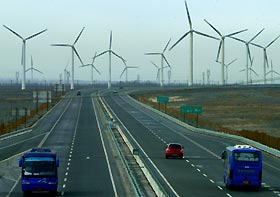|
China looking west for energy supply
By Xie Ye (China Daily)
Updated: 2005-06-21 02:15
A State Council leader has called for a wider exploration of the potentially oil-rich Xinjiang to make the region the country's strategic oil and gas base.
 |
| A wind power plant in Dabancheng, Northwest China's Xinjiang Uyguir Autonomous Region, is viewed in this file photo taken on May 31, 2005. [newsphoto] |
During a recent visit to the Xinjiang Uygur Autonomous Region, Vice-Premier Zeng Peiyan said efforts will be focused on the Tarim, Junggar, and Turpan-Hami basins.
Zeng also said oil companies and local governments should look into price reforms in the energy sector, the levying of a fuel tax and an increase in the resources tax.
The basins, equivalent in size to France and Britain, sit on 30 per cent of China's total oil and 34 per cent of its natural gas reserves. But more than 80 per cent of the areas remains untapped.
"Exploration in Xinjiang is still in an embryonic stage," said Zeng at an oil and gas exploration meeting in Tarim on Sunday.
"We should strive to find large oil and gas fields, and make Xinjiang the country's strategic oil and gas base."
Zeng visited major oil and gas fields in the Tarim Basin late last week after completing a tour of Russia, Oman, the United Arab Emirates, and Qatar - all major oil producers.
Xinjiang pumped 22 million tons of oil last year, or 12 per cent of the nation's total.
Currently China's third largest oil producing region, Xinjiang plans to more than double its oil production to 50 million tons by 2010.
The target, if realized, will place Xinjiang ahead of Daqing in the northeast as the largest oil production base in China.
Beijing also sees Xinjiang as a frontier post from which to pump in imported crude from Central Asian countries.
China and Kazakhstan are building a 1,200-kilometre cross-border oil pipeline to bring in 10 million tons of crude annually from Kazakhstan to Xinjiang.
The pipeline is expected to become operational by the end of the year and plans are in place to double its capacity to 20 million tons in the future.
The development of the oil and gas business will help drive the local economy and create jobs, stabilizing a region where millions of people of about a dozen ethnic minorities live, Beijing hopes.
But experts have warned the prospects of oil exploitation in the region remain uncertain, given its complicated geography. And production costs tend to be much higher than the east as oil companies have to drill deeper in the deserts.
"It is highly risky to explore for oil and gas in Xinjiang," said a veteran engineer with China National Petroleum Corp, the country's largest oil producer.
"More importantly, Xinjiang is far from the major oil markets on the east coast. High transportation costs will largely erode the profit margins of oil companies," the engineer who did not want to be named said yesterday in Beijing.
(China Daily 06/21/2005 page2)
|